2015 nano@illinois RET Teachers Perform Nanotechnology Research, Make Modules
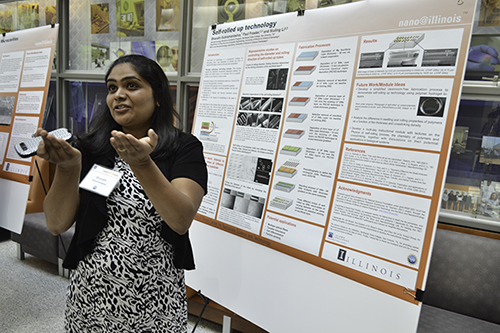
Bharathi Subramaniasiva presents her research on Self-Rolled Up Membranes during the nano@illinois RET poster session.
August 3, 2015
Funded by the National Science Foundation, the nano@illinois Research Experience for Teachers (RET) offered eleven practicing P-20 STEM teachers and one pre-service teacher the chance to do research under some of Illinois’ premier researchers in their state-of-the-art labs. Over the next year, teachers are then to develop a module related to their nanotechnology research that can be used in their own or other classrooms. According to Program Coordinator Carrie Kouadio, the RET's main goal is “that the students will be impacted and can benefit from the teacher's increased enthusiasm, higher content knowledge, and ability to direct them in considering careers.”
While last year was the pilot of the program, in many ways Kouadio considers this year to be a pilot too, “because we expanded from 4 [teachers] to 12, we have the non-local component, and we have more diversity in many ways.”
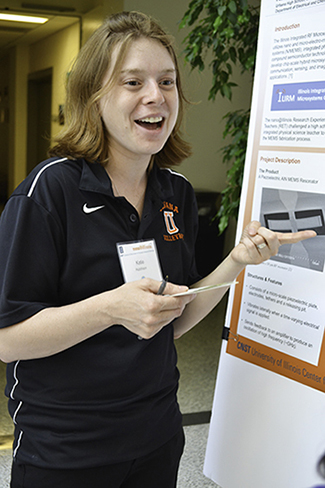
RET participant Katie Hutchison presents the results of her research to a visitor to the nano@illinois RET final poster session.
For example, nine of the twelve teachers are women. Five hail from as far away as Texas and New Mexico. And the diversity is related to not only their content area, but to their years of teaching and educational level. For example, their expertise ranges from one teacher with a PhD who runs a nanotechnology certification program in a community college, to one who just graduated (from Illinois) with his Bachelor’s and will begin teaching this fall.
How did project leaders plan a program that would appeal to such a broad range of training and expertise? Kouadio admits that this was one of the challenges this year:
“I think that’s one of the hard problems to solve when you have such a diverse group. How do you create programming that works for them all?...There is such diversity among the participants; that’s something we strongly consider in the programming and in emphasizing to the presenters who the audience is, then trying to tweak things so they’ll be most useful to the participants.”
She contends that nanotechnology's multidisciplinary and pervasive nature offers a solution: “Nanotechnology encompasses so many areas, so we’re trying to schedule seminars that appeal to different people—to cover the spectrum with that.”
One of their first steps was to “quickly get them all…some kind of baseline understanding,” indicates Kouadio. They began with some rudimentary training: intro to nanotechology, intro to best practices in research, and the standard training anyone would need to get access to the cleanroom.
Their summer schedule looked something like this: Mondays and Tuesdays were professional development sessions: research seminars like those mentioned above, lab tours, hands-on activities, discussions, coffee hour or lunch with an invited guest. Hands-on activities included what Kouadio calls “classic NanoCEMMS activities—the 'best of' nanotechnology modules,” such as 3D printing, gold and silver nanoparticles, and AFM (Atomic Force Microscopy).
Wednesday through Friday teachers were in their labs—doing research, meeting with or shadowing their mentors, reading articles to learn more about their research topic.
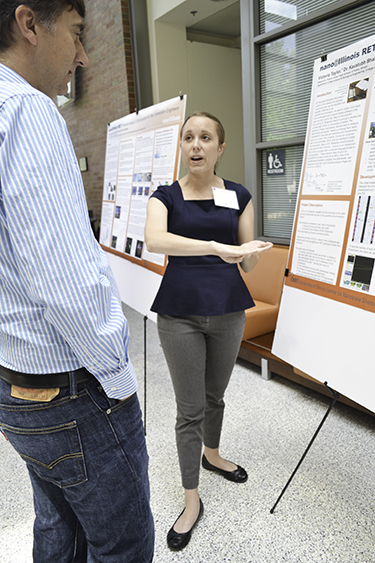
Joe Muskin (left) listens as Victoria Taylor explains her research to him during the RET end-of-program poster session.
Another key component of the RET, in addition to research, was development of a nanotechnology instructional module for teachers, led by Joe Muskin. Kouadio explains the idea behind the modules: “How can they take something from what they did this summer and translate it into a module that’s fully developed?” According to Kouadio, Muskin is helping teachers take their research concept, skill, or something that’s connected in some way, such as a simulation, and translate it into a high-quality, multi-day module that includes a teachers' activity guide, a student guide, assessments, worksheets, a video, etc., to disseminate to teachers nationally through various hubs. The teachers will be working on these over the next year.
And while all the teachers experienced the same introductory and hands-on activities, it was the actual research experiences that gave participants a unique, one-of-a-kind experience.
“For each participant, the experience is very different,” admits Kouadio. “In some cases, they actually spend a lot of time with their faculty mentor…in other cases, a research mentor may have been working with them, primarily.”
Also very different were their research topics, and how they went about performing their research:

Bharathi Subramaniasiva performs research on Self-Rolled Up Membranes in the MNTL clean room.
“Some may be doing computational things, totally computer-focused," reports Kouadio. "Others may be doing processes in the clean room, getting all gowned up and things; they do totally different things; the way that they spend their day is very different; whom they interact with is very different.”
The combination of research training, module development, and unique research experiences made for a multifaceted program: “I knew this program was very complex," acknowledges Kouadio, "but this experience with this new cohort of 12 has reiterated that this program is a really complex program. Even the teachers have commented on it.”
The hoped-for outcome of the RET was that informed and excited the teachers would turn around and pass that on to their students.
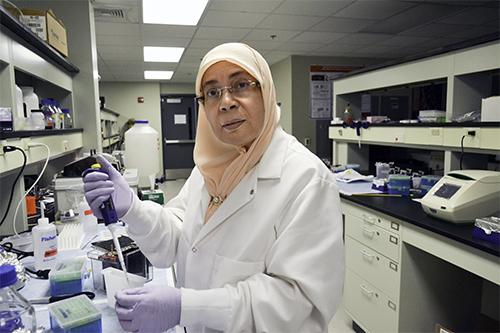
Azza Ezzat works on her her research on receptor differences in cancer cells.
According to Kouadio: “I hope that after this summer experience, they [the teachers] would be rejuvenated in teaching about their field. Also, they would be in a better position to teach their students about the nature of science, how science is practiced, and that they will have first-hand experience, so they can really talk about it.”
Based on the responses of a number of RET participants, this goal was achieved.

CPS teacher Sarah Hughes shares about her research on converting 3D ojects to DNA brick objects.
For instance, Chicago Public Schools teacher Sarah Hughes reports having a paradigm shift regarding the process of science: “Science is not the scientific method that we teach them out of the textbook,” says Hughes. “It’s a lot of trial and error, and it’s very fluid, and you do stuff as it comes to you, not in some specific order.”
Steven Pavlakis, who just graduated from Illinois in May and will begin his career this fall teaching geometry at Urbana High, believes the experience has made him more well rounded. “I’ve gotten to see what’s going on in the real world, the science room…Being in a pure math vacuum, we don’t really see what’s going on “north of Green Street” here on campus. And I’ve gotten to see what’s really going on there.”
Kouadio says their goal was also to expose RET participants to research in a variety of nanotechnology-related fields and disciplines and, thus, better enable these teachers to guide their students regarding career choices in research.
“Say, they have a student that expresses interest in this, they can better help focus and direct them into something that might be a good fit for them. Having been here and exposed to so many different majors with the presenters we have and these different content areas that they can better help see ‘I can see that with your aptitudes and interests, this might be a good thing for you,’ which they may not have even known about if they hadn’t had this experience.”
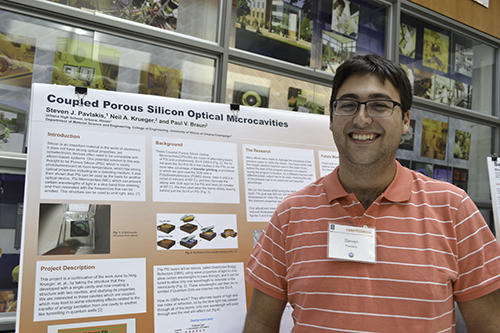
Steven Pavlakis shares about his research on micro cavities during the RET poster session
This was the case for Steven Pavlakis, who indicates he now feels better equipped to respond to students who wonder why they should study a subject.
“I can give my kids an opportunity to understand what’s going on there if they have questions about careers…Students are always like, ‘When am I going to use this?’ Well, I can tell them exactly where they can use it, because I did it this summer.”
The nano@illinois RET is led and administrated by:
- PI Xiuling Li, Electrical and Computer Engineering
- Co-PI Lynford Goddard, Electrical and Computer Engineering
- Irfan Ahmad, Executive Director, Center for Nanoscale Science and Technology, and nano@illinois RET Program Manager
- Carrie Kouadio, Program Coordinator, Center for Nanoscale Science and Technology, and nano@illinois RET Program Coordinator
nano@illinois RET is managed by the University of Illinois Center for Nanoscale Science and Technology at the Micro and Nanotechnology Lab.
Story and photographs by Elizabeth Innes, Communications Specialist, I-STEM Education Initiative.
More: MNTL, Nano@illinois, RET, Summer Research, Teacher Professional Development, 2015
For additional istem articles on the Nano@illinois RET, please see:
- RET Teachers Experience Multidisciplinary Nanotechnology Research via nano@illinois
- Local Science Teachers Experience Research in NanoTechnology
- Local Biology Teacher to Introduce her Students to Research on Quantum Dots
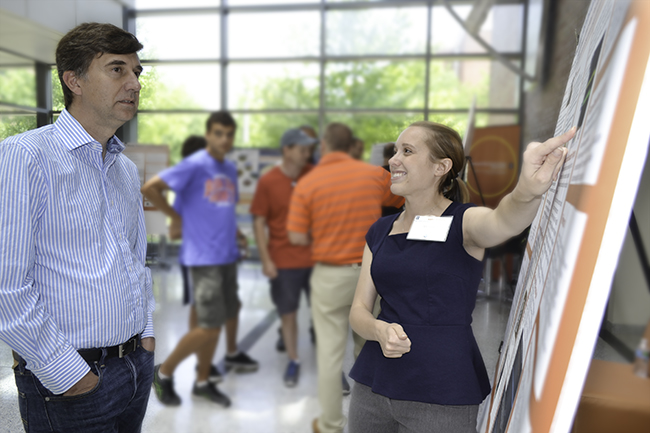
Joe Muskin (left) listens as Victoria Taylor presents her research during the RET end-of-program poster session.













.jpg)
















